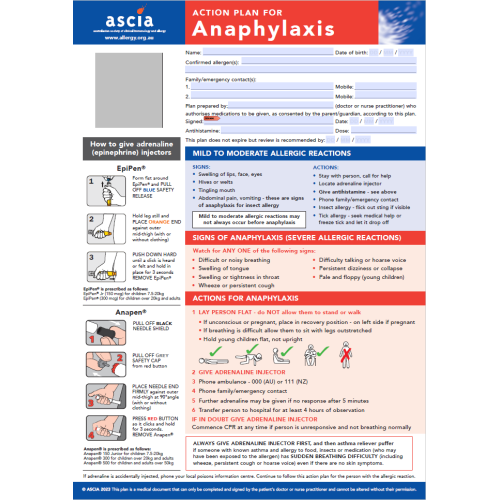Updated April 2025
On this page
If you or the person you are with are showing any signs of a severe allergic reaction
What is Anaphylaxis?
Anaphylaxis is the most severe form of allergic reaction. It affects either a person’s airway and how they breathe, and/or the way blood is moved around the body (blood pressure). It is potentially life threatening and must always be treated as a medical emergency.
The most common causes of anaphylaxis are food, medications and insects. The things that cause or trigger anaphylaxis are called allergens.
The best way to recognise anaphylaxis is by using the ASCIA Action Plan to identify the signs.
Signs of anaphylaxis
Any ONE of the below signs affecting a person’s airway or breathing, or a change in the way blood moves around the body, is a sign of anaphylaxis.
Signs that show the person’s airway and/or breathing has changed:
- Difficult or noisy breathing
- Swelling of the tongue
- Swelling or tightness in throat
- Wheeze or persistent cough
- Difficulty talking or hoarse voice
Signs that show that there has been a change in the way blood moves around the body:
- Persistent dizziness or collapse
- Pale and floppy (young children)
Special note about insect allergy:
- As well as breathing and blood pressure symptoms stated above, abdominal pain and/or vomiting are also signs of anaphylaxis in insect allergy. For more information go to our insect allergy page.
People need to breathe to stay alive, people need blood to get to their heart, lungs and brain to stay alive. If any one sign listed above is present, treat as anaphylaxis. People can have one or more of the above signs which mean they are having anaphylaxis.
Skin symptoms such as hives or facial swelling are not always present when someone has anaphylaxis, or they can develop after a sign/signs of anaphylaxis appear.
Anaphylaxis is what we call an ‘immediate type’ allergic reaction. It will usually happen within the first 20 minutes of a person being exposed to their allergen (the thing they are allergic to) but can take up to 2 hours to develop.
Note: Not all exposures to an allergen will cause anaphylaxis. For example, if a person with peanut allergy touches peanut or a person with egg allergy touches egg, it may cause a mild to moderate allergic reaction involving the skin but it will not cause anaphylaxis. Some people can have anaphylaxis if they eat even a very small amount of the food they are allergic to. Sometimes they will not even know how they ate it. For example, it could have been caused by cross contamination when the food was prepared or if they touched the food, did not wash their hands, and then put their hands in their mouth.
Signs and symptoms of anaphylaxis
Learn about the signs and symptoms of allergic reactions, and the difference between a mild or moderate reaction and a severe reaction (anaphylaxis).
What happens in the body
During an allergic reaction, chemicals are released from special cells called mast cells. Mast cells are found under the skin, along the gastrointestinal (stomach and gut), cardiovascular (heart and blood vessels) and respiratory (breathing) systems in the body. Sometimes only a few mast cells break open and release chemicals which cause a mild to moderate allergic reaction. When many mast cells break open lots of chemicals are released, and this can affect the way a person breathes or the way blood moves around the body (blood pressure) resulting in anaphylaxis.
There are factors that affect how mild or severe an allergic reaction can be. These factors can also have an effect on how quickly or how slowly the allergic reaction happens. For more information click here.
Adrenaline is first-line treatment of anaphylaxis.
Adrenaline helps during anaphylaxis by acting on the body systems involved in breathing and the way blood moves around the body. For more information click here.
Click here for the Australasian Society of Clinical Immunology & Allergy (ASCIA) description of anaphylaxis.
Who is at risk of anaphylaxis?
Anyone with an allergy to food, insects, medications or latex could be at risk of anaphylaxis. There are other less common causes of anaphylaxis too.
People who have an ASCIA Action Plan for Anaphylaxis (red) and are prescribed an adrenaline device are at risk, because many of them have experienced anaphylaxis before.
People (often children) who have an ASCIA Action Plan for Allergic Reactions (green) for food and have not been prescribed an adrenaline device are also at risk, though the risk is not as high because often, they have only had mild to moderate allergic reactions before. These people still need to avoid the food they are allergic to just like those who are prescribed an adrenaline device.
People can experience their first allergic reaction at any age. Their very first allergic reaction could be anaphylaxis.
It’s important to remember that most people who experience anaphylaxis recover from it. Fatal anaphylaxis (dying from anaphylaxis) is most commonly caused by medication or insect stings, particularly in adult males over 50 years of age that have other health conditions. However, there are recorded deaths from food anaphylaxis in Australia. Death from anaphylaxis remains rare.
A delay in having an injection of adrenaline or not having an injection of adrenaline at all is a risk for fatal anaphylaxis. This is why people are prescribed adrenaline devices – so they can get adrenaline quickly once they show signs of anaphylaxis.
It is very important for people with asthma to take medications as prescribed by their doctor. Those at risk of anaphylaxis who also have asthma must make sure they have good daily asthma management because their anaphylaxis may be more severe. The GP and allergy specialist will regularly check for asthma symptoms and may change asthma medication to improve asthma if it is not well managed.
If you are not sure whether someone is having anaphylaxis, it is best to give someone the adrenaline device and call triple zero (000) for an ambulance.
Common allergens which can cause anaphylaxis

Food
- Milk, eggs, peanuts, tree nuts, sesame, fish, crustacea, molluscs, wheat, and soy are the most common food triggers, causing 90% of allergic reactions in Australia.
- BUT any food can cause anaphylaxis.

Bites and stings
- Bee, wasp and jack jumper ant stings are the most common cause of anaphylaxis to insect stings.
- Ticks, green ants and fire ants can also cause anaphylaxis

Drug (Medication)
- Over-the-counter and prescribed medication can cause anaphylaxis.
- People can also have anaphylaxis to herbal, alternative or complementary medicines.
- Examples of medications that people are allergic to include nonsteroidal anti-inflammatory drugs (NSAIDs), antibiotics, pain relief medications and anaesthetics.

Other causes
Other allergens which can cause anaphylaxis, such as latex or exercise, are less common. Occasionally the cause of the anaphylaxis cannot be found. This is called idiopathic anaphylaxis.
Diagnosis of anaphylaxis
The diagnosis of anaphylaxis should always be confirmed by a doctor. When possible, the person should be referred to an allergy specialist
Sometimes anaphylaxis can be diagnosed easily and what caused the reaction is very clear. Sometimes it is more difficult to know what caused the symptoms.
A person who has had anaphylaxis or who is suspected of having anaphylaxis should ask their GP for a referral to see an allergy specialist to confirm the diagnosis, get advice on how to reduce risk of another anaphylaxis and information on what to do if they have another allergic reaction.
See our Diagnosis of allergy and allergy tests page for more information.
If you are diagnosed at risk of anaphylaxis you should be:
- Educated on how to avoid your allergens (triggers).
- Given an ASCIA Action Plan for Anaphylaxis or ASCIA Action Plan for Drug (medication) Allergy to use when you have an allergic reaction. The health professional that gives you the plan should explain how to use the plan to recognise an allergic reaction including anaphylaxis, and then follow instructions on what to do.
- Shown how to use the adrenaline device prescribed to you and have the ASCIA Action Plan for Anaphylaxis that matches that device.
Management of anaphylaxis
People who have been diagnosed at risk of anaphylaxis and prescribed an adrenaline device should have an ASCIA Action Plan for Anaphylaxis. It can be completed by a doctor or nurse practitioner and should be updated each time a new adrenaline device is prescribed or there is a change in allergies.
ASCIA Action Plan for Anaphylaxis
The ASCIA Action Plan for Anaphylaxis is for people who have been prescribed an adrenaline (epinephrine) device. It outlines:
- Which allergens to avoid
- Signs of mild to moderate and severe allergic reactions
- Actions to take
- How to give an adrenaline device
- Emergency contact details
The ASCIA Action Plan for Anaphylaxis should be stored with a person’s adrenaline device.
Awareness is key to managing your risk of anaphylaxis:
1. Know your allergens
- People with allergies and their caregivers need to be educated on how to avoid their allergens.
- You can never remove all risks but you can reduce the risk of having anaphylaxis and be prepared for when accidents happen
2. Know the symptoms of anaphylaxis
- Use the ASCIA Action Plan to help you recognise the signs and symptoms of a mild to moderate allergic reaction and the signs and symptoms of anaphylaxis.
- As accidental exposure to your allergen can happen even though you are careful. People with allergies and their carers need to be able to recognise signs and symptoms of allergic reactions and know what to do.
3. Know what to do when they experience signs and symptoms of anaphylaxis
- Quick action saves lives
- Follow instructions on the ASCIA Action Plan for Anaphylaxis.
- Position the person and give an adrenaline device as directed on the ASCIA Action Plan.
You may wish to wear a medical identification bracelet or necklace. This may help first aiders or health professionals understand what is happening in an emergency.
Be informed and empowered, but try not to be fearful. If your fear stops you from doing everyday activities, get help to manage your anxiety. Read more about managing anxiety here.
Avoidance
People at risk of anaphylaxis are advised to avoid their allergens.
For more information on reducing risk or avoidance see the individual type of allergy below.
Key points about anaphylaxis:
- Anaphylaxis is the most severe form of allergic reaction.
- It can be life threatening and needs to be treated quickly.
- Know your allergens and how to avoid them where possible.
- Use your ASCIA Action Plan to help recognise the signs and symptoms of a mild or moderate allergic reaction and the signs and symptoms of anaphylaxis.
- Know what to do if anaphylaxis happens – follow instructions on your ASCIA Action Plan.
- Always carry (and know how to use) an adrenaline (epinephrine) device (such as EpiPen®, Anapen®).
- If you are not sure if it is anaphylaxis, give the adrenaline device.
- When treated quickly and correctly, most people get better after having anaphylaxis.
Talk with your doctor or nurse practitioner for information on allergic reactions and emergency treatment. Most importantly, make sure that the information you rely on is up to date and from a reliable source.
You can reduce risk of anaphylaxis and treat it when it happens. Work with your doctor or nurse practitioner to help identify your allergens and create a management plan so that you feel confident to live your life. You will need to do some things a little differently to help keep you safe but you should not have to miss out because of your allergy and risk of anaphylaxis





